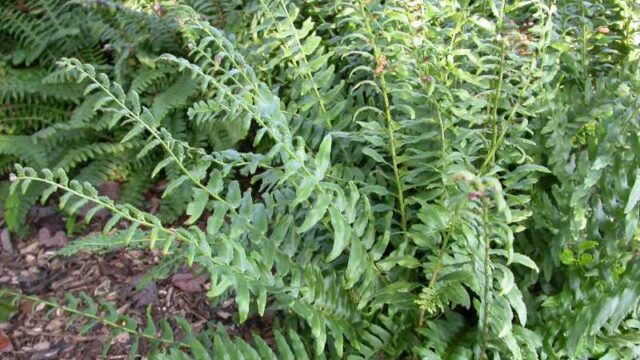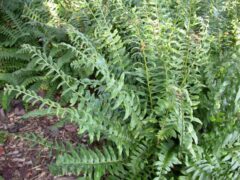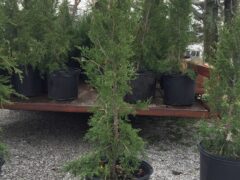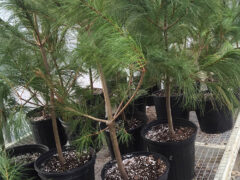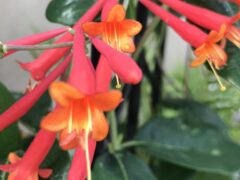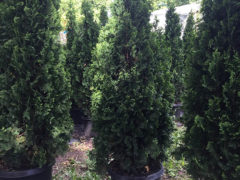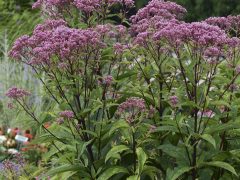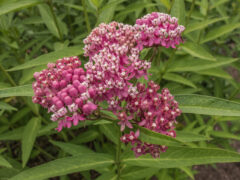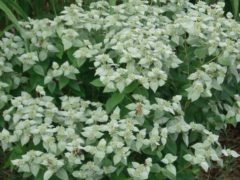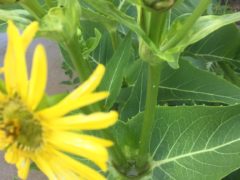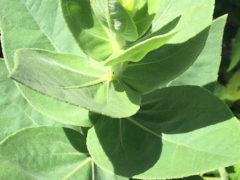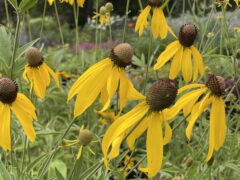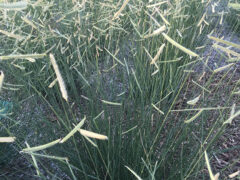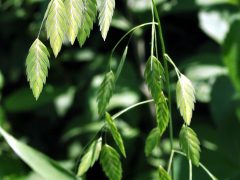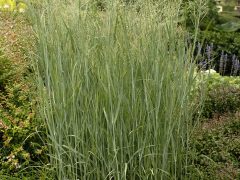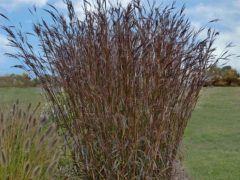While herbaceous plants are dormant you can identify areas in the landscape that might benefit from a punch of winter color and texture. With a little planning, a winter garden can as beautiful as a spring planting — and it can be done with native plants.
Consider evergreen native plants — a low-growing perennial fern, a climbing vine, and a variety of evergreen shrubs and trees in various colors and sizes:
Christmas fern
Polystichum acrostichoides
It stays green through the holidays, hence the name. This hardy, leathery fern has glossy green fronds year-round in clusters from 1-2′ tall. Silvery fiddleheads emerge in early spring. Very easy to establish and grow in moist, well-drained soil in shade. In the right spot, it can be a good, evergreen border or accent plant. Though often used as a groundcover, it is a clumping fern.
‘Taylor’ juniper
Juniperus virginiana ‘Taylor’
'Taylor’ is an upright narrow columnar eastern red cedar selection that grows up to to 30’ tall but only 3’ feet wide. Silvery blue-green foliage is attractive throughout the growing season. Foliage may take on some bronze tones in winter. Full sun to very light shade (6 hours of sun or more)
The parent of this native selection is native to Douglas County, Kansas.Eastern white pine
Pinus strobus
Grows at a fast rate, with height increases of more than 24” per year to a height of 50–80’ and a spread of 20–40’ at maturity, although more often they top out at about 30-35' in our area. Grows in acidic, moist, well-drained and dry soils. Soft, flexible, long, slender, blue-green needles 5” in length grow in bundles of 5. 3–8” cones provide pine seeds for rabbits, red squirrels and many birds, and provide nesting sites for woodpeckers, common grackles, mourning doves, chickadees and nuthatches, to name a few.
'Fastigiata' is a columnar selection that grows 30-40' tall with a spread of only 7-10'.
coral honeysuckle
Lonicera sempervirens
A non-stop bloomer from late spring through the summer with showy clusters of orange-red flowers. Considered to be the most extended blooming variety of honeysuckle and a superior flower for hummingbirds, coral honeysuckle is not generally regarded as invasive. 'Major Wheeler' is a selection with a longer and heavier flowering display than the species, Lonicera sempervirens. However, if you want to have lots of berries, you’ll need another coral honeysuckle that is not 'Major Wheeler'. This allows the flowers of each vine to cross-pollinate and produce more fruit. Both are available at the nursery!
‘DeGroot’s Spire’ arborvitae
Thuja occidentalis ‘DeGroot’s Spire’
Hard-working, versatile, native evergreen. The narrow, pyramid shape makes it a natural choice for windbreaks. It requires almost no care when used as a hedge or screen. Pairs of these hardy trees make great accents for doors and garden gates. Single trees soften house corners. Slow growing, reaching 20 ft. tall and 4 to 5 ft. wide.
The following native plants have woody stems and seed heads for winter texture. These plants also provide shelter for solitary bees that nest in stems:
sweet Joe-pye weed
Eutrochium {Eupatorium} purpureum
Shade tolerant and showy, this easy-to-grow native stays in place in the garden and invites many butterflies and other pollinators to the late summer garden.
swamp milkweed
Asclepias incarnata
Swamp milkweed sports lightly fragrant flower clusters from early summer through fall. Plants grow 3-5' tall. Choose the pure native pink or the selection called 'Cinderella'. As the name suggests, this species is tolerant of poorly drained sites.
short-toothed mountain mint
Pycnanthemum muticum
2025 Perennial Plant Association Plant of the Year®
Attracts beneficial garden insects like crazy — honeybees, butterflies, beneficial wasps, and moths cover the tiny flowers accented by fuzzy white bracts over blue-green foliage, which is incredibly fragrant. A must for any butterfly garden.
Plants are loaded with pulegone, the same insect repellent found in pennyroyal, and can be rubbed on the skin to repel mosquitoes!
cup plant
Silphium perfoliatum
Named for the cup-shaped vase where leaves join the stalk, these tall perennials hold water between rains for insects, amphibians, birds, and small mammals. Flowers are sunflower-like, and plants occur in woods and thickets, meadows, along prairie streams and railroad tracks throughout the Midwest. Stems 4-8’ tall are distinguished by square stems and pairs of cup-forming leaves. 3” flower heads.
downy sunflower, ashy sunflower
Helianthus mollis
Fine hairs cover the stems and leaves, giving this native perennial a gray-green color. A classic sunflower that blooms for summer thru early fall. Thrives in poor, dry soils with gravel, rock or clay where it will form a dense colony. Can prevent other plants from growing around it so use this native in areas where an isolated monoculture can grow. Downy Sunflower is very aggressive--a quality some might look for, but in a small landscape setting it's a plant that could easily take over an entire area.
gray-headed coneflower
Ratibida pinnata
Native plant that thrives in dry woods, prairies and along railroad tracks and roads. Composite flowers have a dull-gray central disk in the shape of an elongated cylinder. Bright yellow ray flowers up to 3" long surround the "cone." Long summer bloom period. Thrives in average to dry, well-drained, clay or sandy soil. Spreads by seed. Excellent for naturalized, meadow and butterfly gardens as well as in mass plantings.
And finally, native grasses can be tucked throughout the landscape for winter interest and texture. Native grasses vary in height to complement any garden:
blue grama grass, mosquito grass
Bouteloua gracilis
A tufted, warm-season native grass with distinctive caterpillar-like seed spikes which hang from one side of each flowering stem. Native to prairies, plains, open rocky woodlands, and along railroad tracks throughout the Western U.S., this was a dominant grass of the dry shortgrass prairies. Narrow, bluish-gray leaf blades form a dense clump 12-15" tall. Foliage turns golden brown, orange, and red in autumn. Inflorescences of purplish-tinged flowers appear on arching stems above the foliage in early to mid-summer, bringing the total height of the clump to 20" tall.
'Blonde Ambition' is a slightly taller selection with showy golden-yellow flowers.
Seed provides food for songbirds including woodpeckers, finches, sparrows, cardinals, grosbeaks, nuthatches, crows, and bluejays.

river oats, northern sea oats
Chasmanthium latifolium
Attractive, nodding seed heads make excellent cut arrangement filler. This grass spreads aggressively so choose your planting site carefully. One of a handful of grasses that will tolerate some shade. [gallery columns="1" link="file" size="medium" ids="6089"]
‘Heavy Metal’ blue switchgrass
Panicum virgatum 'Heavy Metal'
Metalic blue leaves, strictly upright. Never leans or flops, even in heavy rain. Pink tones in inflorescence. Fine specimen with yellow autumn color. Clump spread of 2-3'. Panicum is a larval host for skipper butterfly caterpillars and an overwintering host for bees and other pollinators. [gallery link="file" columns="1" size="medium" ids="6089"]
big bluestem
Andropogon gerardii
This colorful, robust hardy grass is NATIVE FROM CANADA TO MEXICO. Tall foliage turns light red after frost. An excellent backdrop for shrubs and perennials, and also planted with tall flowering natives. Tough, self-sufficient big bluestem is justly famed for restoring damaged soil and compromised sites. 'Dancing Wind' is a selection of this North American native chosen for drought tolerance, adaptability to native soils and low maintenance along with superior red display in autumn. 'Blackhawks' emerges deep green to purple and changing to dramatic black by fall. The caterpillars of several skippers feed on the foliage, including the Delaware Skipper, dusted Skipper, Leonard's Skipper, Cobweb Skipper, Ottoe Skipper, Indian Skipper, and Byssus Skipper. Big Bluestem is an important food plant of the short-winged Meadow Katydid and many leafhoppers. The seeds are eaten by many songbirds, including field sparrows, tree sparrows, and chipping sparrows. The foliage is readily eaten by bison, cattle, and other livestock. [gallery link="file" size="medium" columns="1" ids="6089"]
